By: Jennifer L
View the original article here

The global energy market has become even more unstable and uncertain. Add to this the challenges caused by climate change. To meet future demand, sustainable and affordable energy supplies are a must, raising a question “is green hydrogen energy of the future?”
Recently, hydrogen is leading the debate on clean energy transitions. It has been present at industrial scale worldwide, offering a lot of uses but more so in powering things around us.
In the U.S., hydrogen is used by industry for refining petroleum, treating metals, making fertilizers, as well as processing foods.
Petroleum refineries use it to lower the sulfur content of fuels. NASA has also been using liquid hydrogen since the 1950s as a rocket fuel to explore outer space.
This warrants the question: is green hydrogen the energy of the future?
This article will answer the question by discussing hydrogen and its uses, ways of producing it, its different types, and how to make green hydrogen affordable.
Using Hydrogen to Power Things
Hydrogen (H2) is used in a variety of ways to power things up.
Hydrogen fuel cells produce electricity. It reacts with oxygen across an electrochemical cell similar to how a battery works to generate electricity.
But this also produces small amounts of heat and water.
Hydrogen fuel cells are available for various applications.
The small ones can power laptops and cell phones while the large ones can supply power to electric grids, provide emergency power in buildings, and supply electricity to off-grid places.
Burning hydrogen as a power plant fuel is also gaining traction in the U.S. Some plants decided to run on a natural gas-hydrogen fuel mixture in combustion gas turbines.
Examples are the Long Ridge Energy Generation Project in Ohio and the Intermountain Power Agency in Utah.
Finally, there’s also a growing interest in hydrogen use to run vessels. The Energy Policy Act of 1992 considers it an alternative transportation fuel because of its ability to power fuel cells in zero-emission vessels.
A fuel cell can be 2 – 3 times more efficient than an internal combustion engine running on gasoline. Plus, hydrogen can also fuel internal combustion engines.
- Hydrogen can power cars, supply electricity, and heat homes.
Once produced, H2 generates power in a fuel cell and this emits only water and warm air. Thus, it holds promise for growth in the energy sector.
- The IEA calculates that hydrogen demand has tripled since the 1970s and projects its continued growth. The volume grew to ~70 million tonnes in 2018 – an increase of 300%.
Such growing demand is due to the need for ammonia and refining activities.
Producing hydrogen is possible using different processes and we’re going to explain the three popular ones.
3 Ways to Produce Hydrogen
The Fischer-Tropsch Process:
The commonly used method in producing hydrogen today is the Fischer-Tropsch (FT) process. Most hydrogen produced in the U.S. (95%) is made this way.
This process converts a mixture of gasses (syngas) into liquid hydrocarbons using a catalyst at the temperature range of 150°C – 300°C

In a typical FT application, coal, natural gas, or biomass produces carbon monoxide and hydrogen – the feedstock for FT. This process step is known as “gasification”.
Under the step called the “water-gas shift reaction”, carbon monoxide reacts with steam through a catalyst. This, in turn, produces CO2 and more H2.
In the last process known as “pressure-swing adsorption”, impurities like CO2 are removed from the gas stream. This then leaves only pure hydrogen.
The FT process is endothermic, which means heat is essential to enable the necessary reaction.
The Haber-Bosch Process:
The Haber-Bosch process is also called the Haber ammonia process. It combines nitrogen (N) from the air with hydrogen from natural gas to make ammonia.
The process works under extremely high pressures and moderately high temperatures to force a chemical reaction.
It also uses a catalyst mostly made of iron with a temperature of over 400°C and a pressure of around 200 atmospheres to fix N and H2 together.
The elements then move out of the catalyst and into industrial reactors where they’re eventually converted into ammonia.
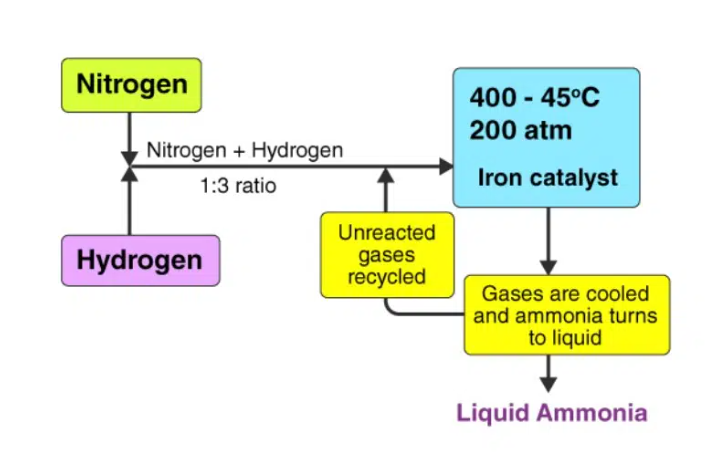
But hydrogen can be obtained onsite through methane steam reforming in combination with the water-gas shift reaction. This step is the same as the FT process, but the input is not carbon but nitrogen.
Both the FT and Haber-Bosch are catalytic processes. It means they require high-temperature and high-pressure reactors to produce H2.
While these two methods are proven technologies, they still emit planet-warming CO2. And that’s because most of the current hydrogen production (115 million tonnes) burns fossil fuels as seen in the chart below.

76% of the hydrogen comes from natural gas and 23% stems from coal. Only ~2% of global hydrogen production is from renewable sources.
This present production emits about 830 million tonnes of CO2 each year.
Thus, the need to shift to a sustainable input and production method is evident. This brings us to a modern, advanced way to produce low-carbon hydrogen or green hydrogen.
The Water Electrolysis Method:
With water as an input, hydrogen features both high efficiency in energy conversion and zero pollution as it emits only water as a byproduct.
That’s possible through the water electrolysis method. It’s a promising pathway to achieve efficiently and zero emission H2 production.
Unlike the FT and Haber-Bosch processes, water electrolysis doesn’t involve CO2.
Instead, it involves the decomposition of water (H2O) into its basic components – hydrogen (H2) and oxygen (O2) via passing electric current. Hence, it’s also referred to as the water-splitting electrolysis method.
Water is the ideal source as it only produces oxygen as a byproduct.
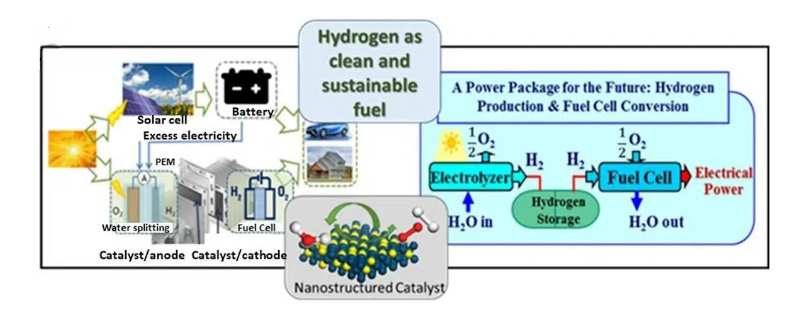
As shown in the figure above, solar energy is used for decomposing water. Then electrolysis converts the stored electrical energy into chemical energy through the catalyst.
The newly created chemical energy can then be used as fuel or transformed back into electricity when needed.
The hydrogen produced via water electrolysis using a renewable source is called green hydrogen, which is touted as the energy for the future.
But there are two other types of hydrogen, distinguished in color labels – blue and grey.
3 Types of Hydrogen: Grey, Blue, and Green
Though the produced H2 have the same molecules, the source of producing it varies.
And so, the different ‘labels’ of hydrogen represented by the three colors reflect the various ways of producing H2.
Processes that use fossil fuels, and thus emit CO2, without utilizing CCS (Carbon Capture & Storage) technology produce grey hydrogen. This type of H2 is the most common available today.
Both FT and Haber-Bosch processes produce grey hydrogen from natural gas like methane without using CCS. Steam methane reforming process is an example.
- Under the grey hydrogen label are two other colors – brown (using brown coal or lignite) and black (using black coal)
On the other hand, blue hydrogen uses the same process as grey. However, the carbon emitted is captured and stored, making it an eco-friendly option.
But producing blue H2 comes with technical challenges and more costs to deploy CCS. There’s a need for a pipeline to transport the captured CO2 and store it underground.
What makes green hydrogen the most desirable choice for the future is that it’s processed using a low carbon or renewable energy source. Examples are solar, wind, hydropower, and nuclear.
The water electrolysis method is a perfect example of a process that creates green H2.
In a gist, here’s how the three types of hydrogen differ in terms of input (feedstock) and byproduct, as well as their projected costs per kg of production.
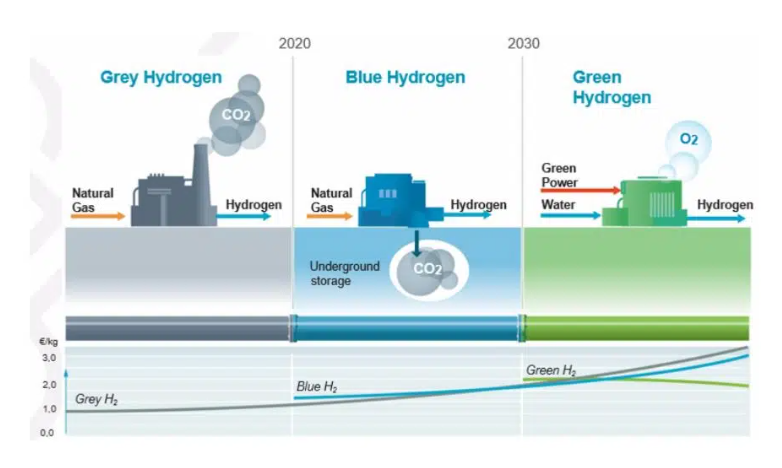
Since the process and the byproduct of producing green hydrogen don’t emit CO2, it’s seen as the energy of the future for the world to hit net zero emissions.
That means doing away with fossil fuels or avoiding carbon-intensive processes. And green H2 promises both scenarios.
But the biggest challenge with this green hydrogen is the cost of scaling it up to make it affordable to produce.
Pathways toward Green Hydrogen as the Energy of Future
As projected in the chart above, shifting from grey to green H2 will not likely happen at scale before the 2030s.
The following chart also shows current projections of green hydrogen displacing the blue one.
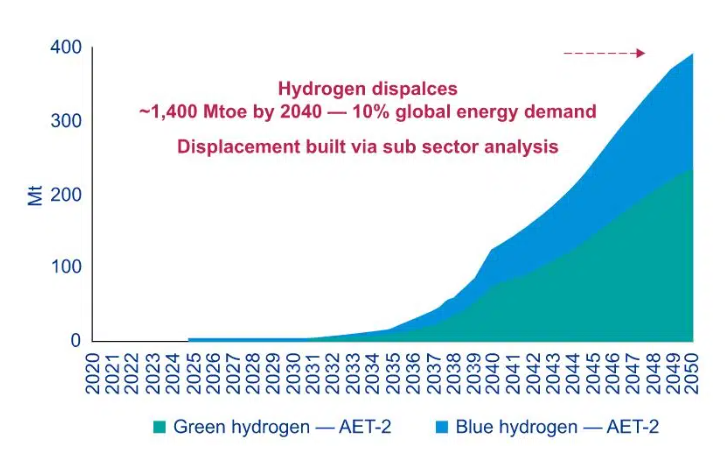
The projections show an exponential growth for H2. What we can think out of this is that green hydrogen will take a central role in the future global energy mix.
- While it’s technically feasible, cost-competitiveness of green H2 becomes a precondition for its scale up.
Cheap coal and natural gas are readily available. In fact, producing grey hydrogen can go as low as only US$1/kg for regions with low gas or coal prices such as North America, Russia, and the Middle East.
Estimates claim that’s likely the case until at least 2030. Beyond this period, stricter carbon pricing is necessary to promote the development of green H2.
According to a study, blue hydrogen can’t be cost competitive with natural gas without a carbon price. That is due to the efficiency loss in converting natural gas to hydrogen.
In the meantime, the cost of green hydrogen from water electrolysis is more expensive than both grey and blue.
- Estimates show it to be in the range of US$2.5 – US$6/kg of H2.
That’s in the near-term but taking a long-term perspective towards 2050, innovations and scale-up can help close the gap in the costs of hydrogen.
For instance, the 10x increase in the average unit size of new electrolyzers used in water electrolysis is a sign of progress in scaling up this method.
Estimates show that the cost of green H2 made through water electrolysis will fall below the cost of blue H2 by 2050.
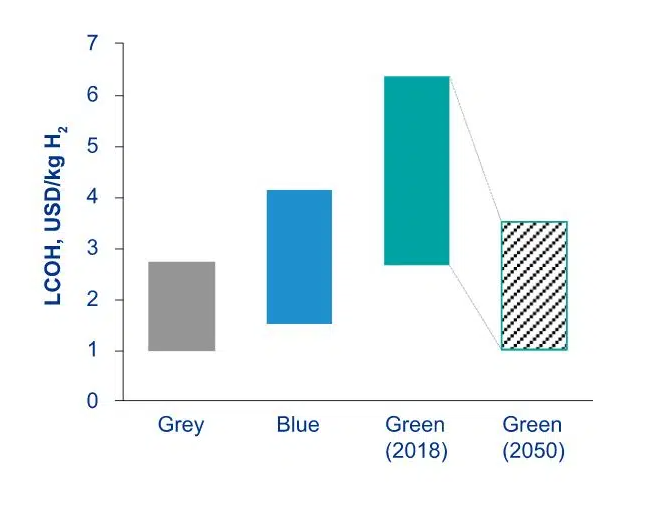
More importantly, while capital expenditure (CAPEX) will decline, operation expenditure (OPEX) such as fuel is the biggest chunk of producing green hydrogen.
- Fuel accounts for about 45% – 75% of the production costs.
And the availability of renewable energy sources affects fuel cost, which is the limiting factor right now.
But the decreasing costs for solar and wind generation may result in low-cost supply for green H2. Technology improvements also boost efficiency of electrolyzers.
Plus, as investments in these renewables continue to grow, so does the chance for a lower fuel cost for making green H2.
- All these increase the commercial viability of green hydrogen production.
While these pathways are crucial for making green hydrogen, the grey and blue hydrogen productions do still have an important role to play.
They can help develop a global supply chain that enables the sustainability and eventuality of green H2.
When it comes to the current flow of capital in the industry, there have been huge investments made into it.
Investments to Scale Up Green H2 Production
Fulfilling the forecast that green hydrogen will be the energy of the future requires not just billions but trillions of dollars by 2050 – about $15 trillion. It means $800 billion of investments per year.
That’s a lot of money! But that’s not impossible with the amount of capital available in the sector today.
Major oil companies have plans to make huge investments that would make green H2 a serious business.
For instance, India’s fastest-growing diversified business portfolio Adani and French oil major TotalEnergies partnered to invest more than $50 billion over the next 10 years to build a green H2 ecosystem.
An initial investment of $5 billion will develop 4 GW of wind and solar capacity. The energy from these sources will power electrolyzers.
Also, there’s another $36 billion investment in the Asian Renewable Energy Hub led by BP Plc. It’s a project that will build solar and wind farms in Western Australia.
The electricity produced will be used to split water molecules into H2 and O2, generating over a million tons of green H2 each year.
Other large oil firms will follow suit such as Shell. The oil giant decided to also invest in the sector. It’s building the Holland Hydrogen I that’s touted to be Europe’s biggest renewable hydrogen plant.
Green Hydrogen as the Energy of the Future
If the current projections of green hydrogen become a reality, it has the potential to be the key investment for the energy transition.
